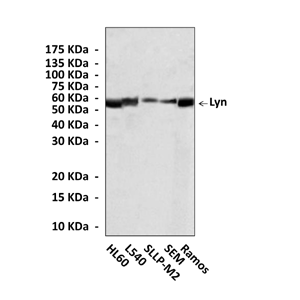Product Sheet CP10318
Description
BACKGROUND Src kinases consist of eight non-receptor tyrosine kinases (Src, Fyn, Yes, Lck, Lyn, Hck, Fgr and Blk) that interact with the intracellular domains of growth factor/cytokine receptors, GPCRs and integrins. Members of the Src kinase family have a very similar domain structure with a high degree of homology in the SH1 (catalytic), linker, SH2 (p-Tyr binding), SH3 (protein-protein interaction) and SH4 (membrane association) domains.1 c-Src, Fyn and Yes are ubiquitously expressed, although high levels of c-Src are found in platelets, neural tissue and osteoclasts. For c-Src, autophosphorylation of Tyr416 and dephosphorylation of Tyr527 is required to switch the kinase from the inactive closed formation to the active open formation. c-Src can be inactivated by two kinases, c-Src kinase (CSK) and CSK homologous kinase (CHK), both of which phosphorylate Tyr527 of c-Src. The activity of the Src kinase family can also be regulated by phosphatases (e.g. SHP1), binding to adaptor proteins (e.g. Cbp) and proteasomal degradation. Src kinases are key upstream mediators of both the PI3-K and MAPK signaling pathways, and have been shown to have important roles in cell proliferation, migration and survival.2
Lyn, one of several Src-family tyrosine kinases in immune cells, has two isoforms p53Lyn and p56Lyn, resulting from alternative splicing of Lyn mRNA. It is preferentially expressed in B cells as well as other hematopoietic cells, but not in T cells. Lyn is noted for its ability to negatively regulate signaling pathways through phosphorylation of inhibitory receptors, enzymes, and adaptors. Somewhat paradoxically, it is also a key mediator in several pathways of B cell activation, such as CD19 and CD180. Whether Lyn functions to promote or inhibit immune cell activation depends on the stimulus and the developmental state, meaning that the consequences of Lyn activity are context dependent. The importance of regulating Lyn activity is exemplified by the pathological conditions that develop in both lyn-/- and lyn gain-of-function mice (lyn up/up), including lethal antibody-mediated autoimmune diseases and myeloid neoplasia.3
Lyn, one of several Src-family tyrosine kinases in immune cells, has two isoforms p53Lyn and p56Lyn, resulting from alternative splicing of Lyn mRNA. It is preferentially expressed in B cells as well as other hematopoietic cells, but not in T cells. Lyn is noted for its ability to negatively regulate signaling pathways through phosphorylation of inhibitory receptors, enzymes, and adaptors. Somewhat paradoxically, it is also a key mediator in several pathways of B cell activation, such as CD19 and CD180. Whether Lyn functions to promote or inhibit immune cell activation depends on the stimulus and the developmental state, meaning that the consequences of Lyn activity are context dependent. The importance of regulating Lyn activity is exemplified by the pathological conditions that develop in both lyn-/- and lyn gain-of-function mice (lyn up/up), including lethal antibody-mediated autoimmune diseases and myeloid neoplasia.3
REFERENCES
1. Homsi, J. et al: Expert Opin. Ther. Targets 11:91-100, 2007
2. Brickell, P. M. et al: Crit. Rev. Oncol. 3:401-11, 1993
3. Xu, Y. et al: Immunity 22:9-18, 2005
2. Brickell, P. M. et al: Crit. Rev. Oncol. 3:401-11, 1993
3. Xu, Y. et al: Immunity 22:9-18, 2005
Products are for research use only. They are not intended for human, animal, or diagnostic applications.
Details
Cat.No.: | CP10318 |
Antigen: | Raised against recombinant human Lyn fragments expressed in E. coli. |
Isotype: | Mouse IgG1 |
Species & predicted species cross- reactivity ( ): | Human, Mouse, Rat |
Applications & Suggested starting dilutions:* | WB 1:1000 IP 1:50 IHC n/d ICC n/d FACS n/d |
Predicted Molecular Weight of protein: | 53/56 kDa |
Specificity/Sensitivity: | Detects endogenous Lyn proteins without cross-reactivity with other family members. |
Storage: | Store at -20°C, 4°C for frequent use. Avoid repeated freeze-thaw cycles. |
*Optimal working dilutions must be determined by end user.
Products
| Product | Size | CAT.# | Price | Quantity |
|---|---|---|---|---|
| Mouse Lyn Antibody: Mouse Lyn Antibody | Size: 100 ul | CAT.#: CP10318 | Price: $472.00 |

